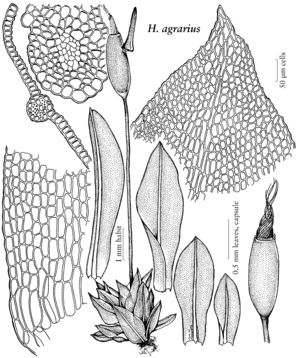Hyophiladelphus agrarius
Bryologist 98: 372. 1995,.
Stems densely rhizoidiferous. Leaf margins occasionally weakly serrulate near apex, occasionally 2-stratose on margins or medial portion of the lamina, marginal cells rhomboid and thick-walled near apex, proximal laminal cells 20–25 µm wide, 2–4: 1, walls thin. Interior perichaetial leaves ca. 1.5 mm. Seta redbrown, twisted clockwise proximally, often also counterclockwise distally. Theca redbrown, commonly sulcate, peristome teeth with many articulations, twisted 1.5–2 times, proximal membrane 45–100 µm in height, granulate to spiculose, operculum 0.8–1.5 mm, cells twisted counterclockwise. Calyptra smooth, 1.4–2.1 mm. Spores light-brown, weakly papillose.
Phenology: Sporophytes mature through much of the year, but mainly winter (Jan–Feb).
Habitat: Low areas, limestone and masonry walls, shady, moist areas
Distribution

Ala., Fla., Ga., S.C., Tex., Mexico, West Indies, Central America (Guatemala), South America (Brazil)
Discussion
Hyophiladelphus agrarius grows as a low crust, often with cyanobacteria. Characters affording immediate recognition are the ovate leaves with distal laminal cells bulging adaxially, two stereid bands in the costa, and the peristome twisted. Curiously, though common in Florida, it is not found in the Atlantic counties of that state according to R. S. Breen (1963).
Selected References
None.
